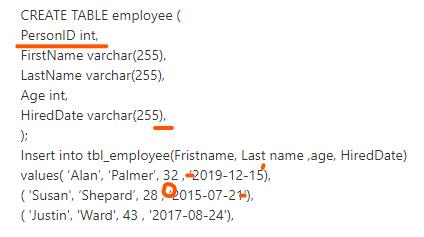I just tried the script (originally didn't test). This works fine in SQL Server:
CREATE DATABASE TableInsert;
GO
USE TableInsert;
CREATE TABLE employee (
PersonID int identity(1,1) primary key,
FirstName varchar(30) NULL,
LastName varchar(50) NULL,
Age int,
HiredDate date
);
Insert into employee(Firstname, LastName, age, HiredDate)
values( 'Alan', 'Palmer', 32 , '2019-12-15'),
( 'Susan', 'Shepard', 28 , '2015-07-21'),
( 'Justin', 'Ward', 43 , '2017-08-24') ;
SELECT * FROM employee;
Few observations: Note that I changed the types and I used date type for the HiredDate. It is always a good idea to use proper SQL data type in order to avoid bad data. Now, there is a debate if we want to use singular or plural for the table name. I would probably use plural. I also specified that Id colum is a primary key and it's incremented automatically.
